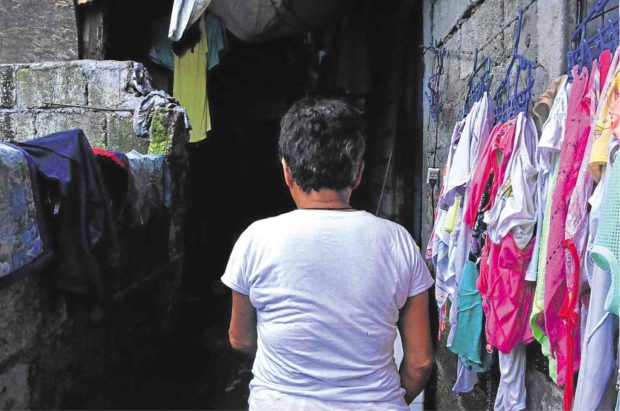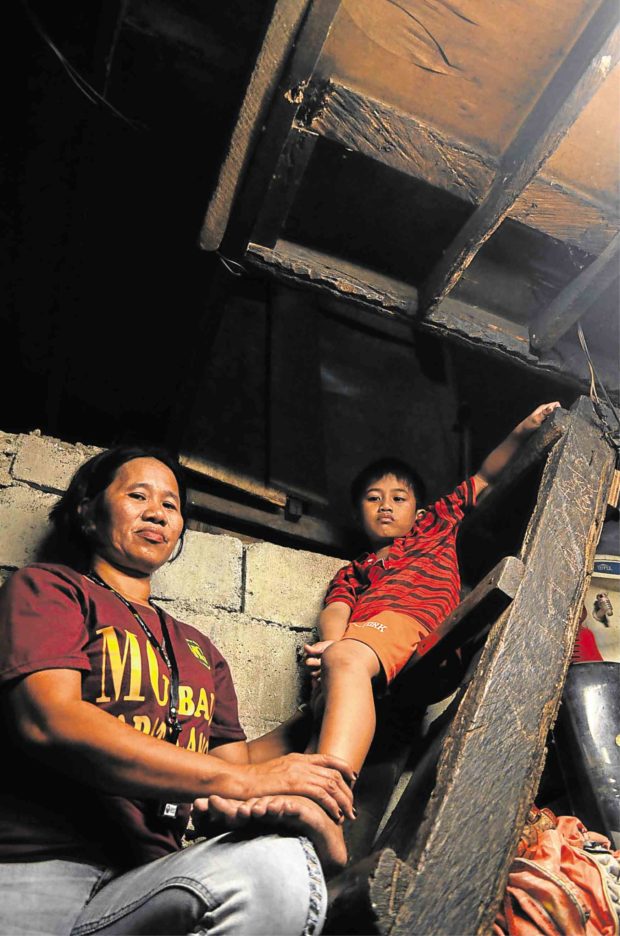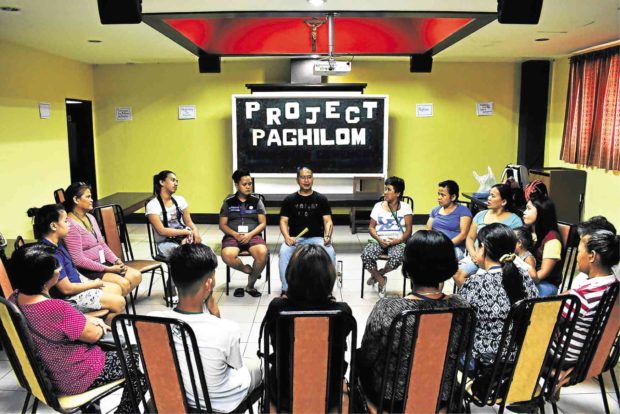It was raining on the night of June 7 when her 33-year-old son, Jose, was killed, “Cora” begins, her voice cracking. Around her, 16 other women listen to a tragic and familiar story.
She was roused from sleep outside their house in Parola Compound, a community of informal settlers in impoverished Tondo, Manila. Police in plainclothes had seized Jose. He was shouting for his mother as they dragged him to an alley beyond her sight.
Cora was whisked from the scene just as two gunshots pierced the air. It was 2 a.m. When she doubled back minutes later, she found Jose dead in a pool of blood and rainwater.
In his right hand was a .38-caliber pistol. He fought back, police said. “Nanlaban.”

PAINFUL PATH Cora, 64, returns to the narrow alley where her son, Jose, was shot dead by the Manila police near their shanty at Parola Compound in Tondo. —KRIXIA SUBINGSUBING
But Cora recalls how Jose begged for his life before he was killed. “He was shouting for me to help him, that he was innocent,” she says, weeping. “And yet they shot him—those merciless policemen.”
Cora’s anguish seems to bounce off the walls of a small room in a spiritual center in Manila, one of a few sanctuaries for survivors like herself. Here, the mothers and widows of men killed in the Duterte administration’s war on drugs try to come to terms with their loss in the course of the arduous journey toward healing.
Central to these efforts is the Church, which is standing as liaison in view of state failure to address the survivors’ plight.
More than providing spiritual support, the Church has mobilized civil society organizations to help meet their urgent need for psychological, financial and legal assistance.
After all, healing means not just getting over their tragedy but also liberating themselves from victimhood.
Cora is one of dozens of women under the wing of activist priest Flavie Villanueva, who in 2016 launched a program to help the families of victims of extrajudicial killings (EJKs) in the drug war.
Aptly called “Paghilom” (healing), it is one of several Church-led initiatives to help those whom Villanueva described as “at the peripheries of economy and faith.”
It may be the only comprehensive institutional program for EJK survivors.
Now ministering to its third batch, Paghilom is backed by human rights and private groups either tapped by Villanueva or that have volunteered to address five needs: food and healthcare, legal assistance, spirituality, education and livelihood.
All these have to go together to truly be of help, says Edel Hernandez, executive director of Medical Action Group (MAG), which provides psychomedical help to the survivors.
With the survivors stigmatized and without resources to “move on,” the goal is to empower them and provide them with the tools to rebuild their lives.
In Cora’s batch are the mothers and wives from the high-profile Payatas “Tokhang” case in 2016 that won a landmark Supreme Court decision ordering the police to stay away from their homes, including Mariza Hamoy, mother of 17-year-old Darwin and one of three who filed murder charges against the “Davao Boys” from the Batasan police station, and Michelle Pineda, mother of 13-year-old Aldrinne who was shot dead by a policeman in a Tondo slaughterhouse.

TELLING THEIR STORY Mariza Hamoy and her son, Daniel, are among the regular participants of the “Paghilom” (healing) sessions held every Saturday by a local parish in Tayuman, Manila. She earlier lost an older son in a “drug bust” conducted by the Quezon City police. —KRIXIA SUBINGSUBING
These are all compelling women but in their “safe space,” they are burdened by their shared narrative. Guided by psychiatrists and counselors, they tell their stories, play games, dine together — friends who found kinship in grief.
At the program’s onset, MAG administers a psychological assessment test to determine the extent of the women’s trauma, which will serve as the basis for the sessions’ activities. The assessment also determines whether the women need further counseling or even medical prescriptions.
The immediate need of most of the survivors is psychomedical intervention, says MAG program director Amy Abcede. In many, their loss results in mental and emotional anguish close to posttraumatic stress disorder: sleeplessness, severe anxiety, intermittent flashbacks.
It’s why Mitos Kawata decided to seek refuge in Paghilom over a year after the death of her son, Hideyoshi, a graduating high school student. Hide, 17, was killed in her house at Barangay Bagong Barrio in January 2017 after allegedly confronting Caloocan police with an Uzi. The real target was her partner, Kawata says.
After almost 18 months of moving from house to house across the metro in an attempt to flee the near-daily nightmare of gunshots, Kawata relented. She couldn’t stop thinking about her son. “I felt that he wouldn’t let me rest.”
Even more worrisome is how the trauma manifests in children, like Hamoy’s son, Daniel, whose brother Darwin was killed along with three others in an alleged buy-bust in August 2016. The unexpected loss made Daniel, then only 6, prone to violence and fits of rage.
Hamoy recalls being summoned by Daniel’s kindergarten teacher because he was always getting into fights and pulling the hair of his classmates.
“We’re worried about him,” she sighs. “He always says he’d study hard to become a policeman. He says he wants to kill them all.”

SUPPORT NETWORK Through Fr. Flavie Villanueva’s “Paghilom” program, grieving families are introduced to civil society groups that could provide them assistance in the form of psychological counseling, financial aid or legal representation. —FATE COLOBONG AND IANNA AGUS
Such feelings of anger can only be purged with the help of others, according to psychologist and session facilitator Nicolas Poblacion. “The survivors need to feel that they are not alone. That helps alleviate the pain and trauma.”
The women consider one another sounding boards for their sorrow. On one Saturday, they sit in a bonfire circle as each recounts her story. Only a few manage without tears; the rest, like Cora, still ache at the memory.
But the retelling is essential for catharsis, Poblacion says. They need to find emotional release in the comfort and audience of their fellow survivors.
Meanwhile, children like Daniel engage in art therapy and games so that their grief would not turn into rage. But they prefer to run around during the sessions to observe their mothers. When the women weep during the sessions, so do the kids—an automatic response to a trauma that a mother and her child need to process together.
With the program’s psychologists and legal partners, each survivor’s case is documented through affidavits and other supporting papers. The psychological harm suffered by each woman is assessed for when a reparations board, much like the one for martial law survivors, is formed in the future.
But with mouths to feed, the women’s primary concern is money. Because most are unemployed or work odd jobs, Paghilom connects the families to sponsors that can provide scholarships and capital for livelihood.
The women receive a travel allowance and groceries each session. “It’s challenging to be consistent,” Villanueva notes, adding: For healing to occur, they must not tire of returning.
Under Paghilom, 18 women in the first two batches have completed the four-month, 16-session “course.” Follow-up visits are conducted by coordinators from De La Salle University.
Cora and the rest of the third batch are in their first two months. The goal is not for them to forget but to live through their “righteous indignation,” Poblacion says. “You can never take that away from them. But you want them to function so they can return to their normal life. You can only do that by shoring up their capacity to survive.”
Ultimately, healing means the survivors’ empowerment—through assistance, education and the tools to pursue justice.
“Once that happens, the cycle [of victimization] stops,” Hernandez says.
Part 1: Healing wounds, finding a voice after nights of ‘nanlaban’
Part 3: ‘Nanlaban’ victims unfazed by legal hurdles